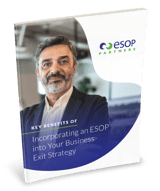Both MBOs and ESOP sales can involve a limited purchase price for the business compared with a strategic third-party buyer. Management employees usually don’t have the means to pay that kind of premium, and business valuation puts limits on what can be financed. Similarly, an ESOP sale guarantees fair market value for the business and relies on valuation expertise to arrive at the sale price, rather than a strictly negotiated number.
An ESOP sale allows the business owner to stay on after the sale as an employee of the ESOP-owned company. Similar agreements may be part of MBO negotiations, which would allow the seller to continue working and slowly transition out of the organization. But it’s not guaranteed, and the seller may need an alternative plan if terms for remaining don’t pan out.
Both ESOPs and MBOs should incorporate succession planning into the long-term process, with a focus on goals of operational continuity and ongoing business growth.
Major Differences Between MBOs and ESOPs
Many of the biggest differences between these two business transition options have to do with regulatory aspects of ESOPs, since they’re qualified retirement plans and subject to regulation under the IRS and the Department of Labor. Because of the regulatory aspects, an ESOP transition actually often involves a fairly predictable path, starting with an initial feasibility study that determines whether an ESOP is a viable option.
An ESOP also requires specific roles and structures to be established. Many businesses work closely with an ESOP consultant, an independent valuation professional, an ESOP trustee, and a third-party administrator through the transition and beyond, to stay compliant with ERISA regulations, and to follow best practices to help ensure healthy cash flow for a well-funded ESOP, a healthy business, and reliable repayment of seller notes and bank loans.
While an MBO transaction is typically for the entirety of a business, ESOPs allow for partial sales. So for the owner who wants to access some of the cash without giving up all ownership stakes, or in the case of multiple shareholders who disagree, an ESOP can offer a solution. Sales of smaller percentages might not even require bank financing in some cases.
An ESOP’s tax advantages represent a major point of differentiation. A seller of a C corporation to an ESOP may be able to defer capital gains tax on the sale. Going forward, contributions to the ESOP are tax deductible for the business, and ESOP-owned S corporation stock isn’t subject to income tax. Those tax benefits help put the company in a strong cash position, which facilitates growth and continued success … and that can reduce repayment risk on seller notes.
In fact, on average, ESOP companies tend to outperform non-employee owned businesses and keep more of their workers employed, especially during challenging times like the 2008 financial crisis and the COVID-19 pandemic. For the seller with a strong interest in leaving a legacy, an ESOP can be an attractive exit strategy.
Key Considerations for the Selling Business Owner
It’s important to begin thinking about the ownership transition well in advance. These questions can be a helpful starting point to compare the MBO and ESOP options:
- Why do you want employees to take ownership of the business?
- Do you think all employees are capable of thinking and acting like owners?
- Financially, what do you need from the sale?
- How long do you intend to remain working, and do you want to stay in your role after the sale?
- How confident are you in the company’s continued success after the transition?
As your planned business exit nears, you’re likely to have questions about which exit strategy makes the most sense for you, for the business you spent your life building, and for the loyal employees who helped you succeed. Learn more about your options when you download Your Ultimate Guide to Business Exit Strategies. Click the link below to claim your free copy today.


